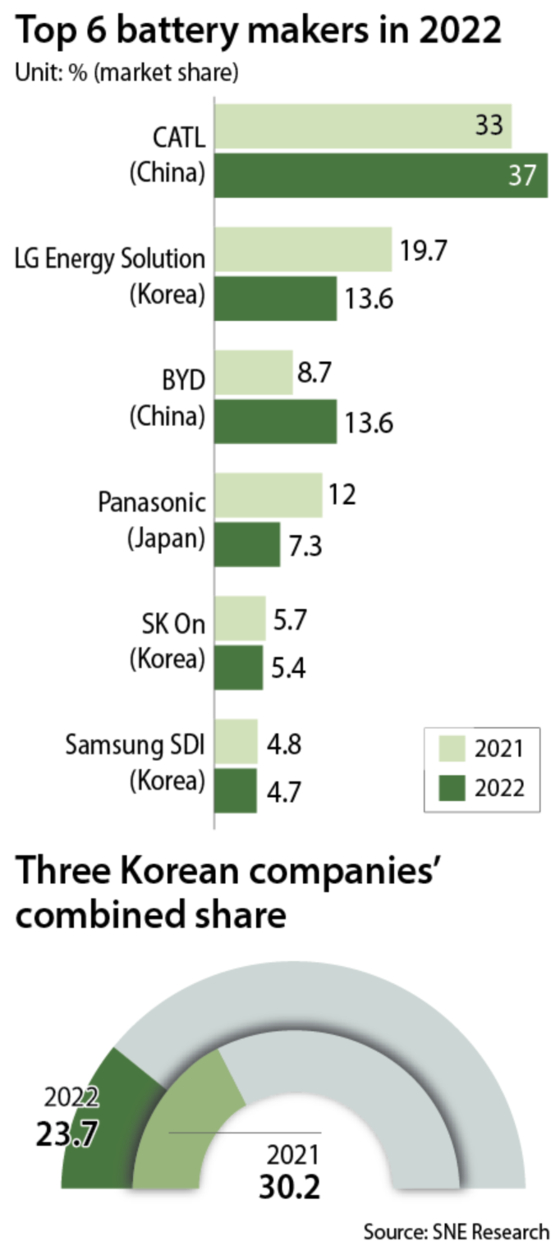[NEWS IN FOCUS] CATL's Ford deal throws Korean battery makers for a loop
![Ford Motor CEO Jim Farley announces $3.5 billion battery plant in Michigan using CATL's LFP battery technology on Feb. 13. [REUTERS/YONHAP]](https://koreajoongangdaily.joins.com/data/photo/2023/02/15/1f93baf4-1a35-40b5-99af-0e9135e8371d.jpg)
Ford Motor CEO Jim Farley announces $3.5 billion battery plant in Michigan using CATL's LFP battery technology on Feb. 13. [REUTERS/YONHAP]
Ford announced Tuesday that it will build a $3.5 billion EV battery plant in Michigan using lithium-iron-phosphate, or LFP, battery technology and technical expertise from Contemporary Amperex Technology (CATL), the Chinese company that has the largest share in the market.
This will allow the Ningde, China-based company to gain access to the U.S. market despite the newly passed Inflation Reduction Act (IRA) making it difficult for batteries with Chinese components and minerals to be sold in the United States.
The Michigan-based automaker will hold 100 percent of the CATL plant instead of establishing a joint venture, which differs from other recent deals struck between car companies and Korean battery makers.

“Under Ford’s strategy, Ford vehicles that are equipped with CATL batteries will be eligible for the IRA tax credit as they are made in Michigan,” said Park Chul-wan, a professor at Seojeong University’s smart car engineering department.
“The bigger problem is that if this strategy works, other EV makers like General Motors and Stellantis are highly likely to take similar steps,” Park added.
The U.S. IRA prevents buyers of cars containing components from a “foreign entity of concern” — a reference to China, Iran, Russia and North Korea — from receiving up to a $7,500 tax credit for EVs assembled in North America.
Details about the battery component rules will be issued in March by the U.S. Treasury Department.
“Demand for LFP batteries is still high, and in these circumstances, there is no way automakers rule China out in this cutthroat EV competition,” Park said.
Despite less energy density, LFP batteries are largely favored by global automakers lately due to their cheaper price tags compared to today’s batteries containing nickel, cobalt and manganese (NCM). They are known to be around 30 percent cheaper than NCM batteries.
Ford said its Mustang Mach-Es, the most popular EV from the brand, will begin using LFP batteries starting this year, followed by the F-150 Lightning trucks in 2024. It came after a series of studies found that Mach-Es are driven 32 miles or fewer a day.
Tesla is already using LFP batteries in its Model 3 and Model Y vehicles. Volkswagen and Stellantis are also increasing the usage of cheaper LFP batteries.
“The latest Ford-CATL partnership implies that cheaper batteries will be the next big thing in the EV market in some two to three years,” said Chang Jung-hoon, a researcher from Samsung Securities.
“Chinese company’s top-tier position in LFP batteries will be solidified.”
![The BlueOval SK Battery Park Kentucky in Glendale, Kentucky. SK On and Ford are building two EV plants there. [SK ON]](https://koreajoongangdaily.joins.com/data/photo/2023/02/15/e7bab407-51d8-4394-97e7-3f25ff7e1e2f.jpg)
The BlueOval SK Battery Park Kentucky in Glendale, Kentucky. SK On and Ford are building two EV plants there. [SK ON]
Korean battery makers are scrambling to develop their own versions of the cheaper batteries.
LG Energy Solution and Samsung SDI are betting big on the so-called “high-manganese battery,” which refers to batteries made with about 70 percent less nickel and cobalt, the two most expensive raw materials.
LG Energy Solution plans to shift its Nanjing plant to an LFP battery-dedicated facility.
SK On recently succeeded in developing a pilot product of battery completely free of cobalt. The mass production will likely come as early as 2024.
Three Korean battery makers are continually losing share to Chinese competitors, with less than a quarter of the entire market as of last year.
They held a combined 23.7 percent of the global EV battery market last year, down 6.5 percentage points from the year-earlier period.
Of the 10 largest battery makers in the world, six were Chinese companies. They held 60.4 percent of the battery market last year, compared to 48.2 percent in 2021.
BY SARAH CHEA [chea.sarah@joongang.co.kr]










with the Korea JoongAng Daily
To write comments, please log in to one of the accounts.
Standards Board Policy (0/250자)